Detailed Report on Managing an Operational Plan for Business
VerifiedAdded on 2023/06/07
|10
|2752
|251
Report
AI Summary
This report provides a comprehensive analysis of operational plan management, covering key aspects such as development, production workflow, industry associations, supply chains, and quality control. It explores the role of stakeholders, including owners, directors, staff, customers, and partners, and outlines effective communication strategies. The report delves into budgeting processes, emphasizing objective setting, resource analysis, and budget monitoring. It also examines the importance of operational plans in achieving organizational objectives, including the "what, who, when, and how much" of operational strategies. Furthermore, the report details methods for monitoring and reviewing operational performance through various cycles, analyzing budget performance, identifying underperformance areas, and recommending solutions, including specific examples, data utilization, and employee input. Finally, it addresses negotiating recommendations for variations to operational plans, emphasizing risk management and performance monitoring.
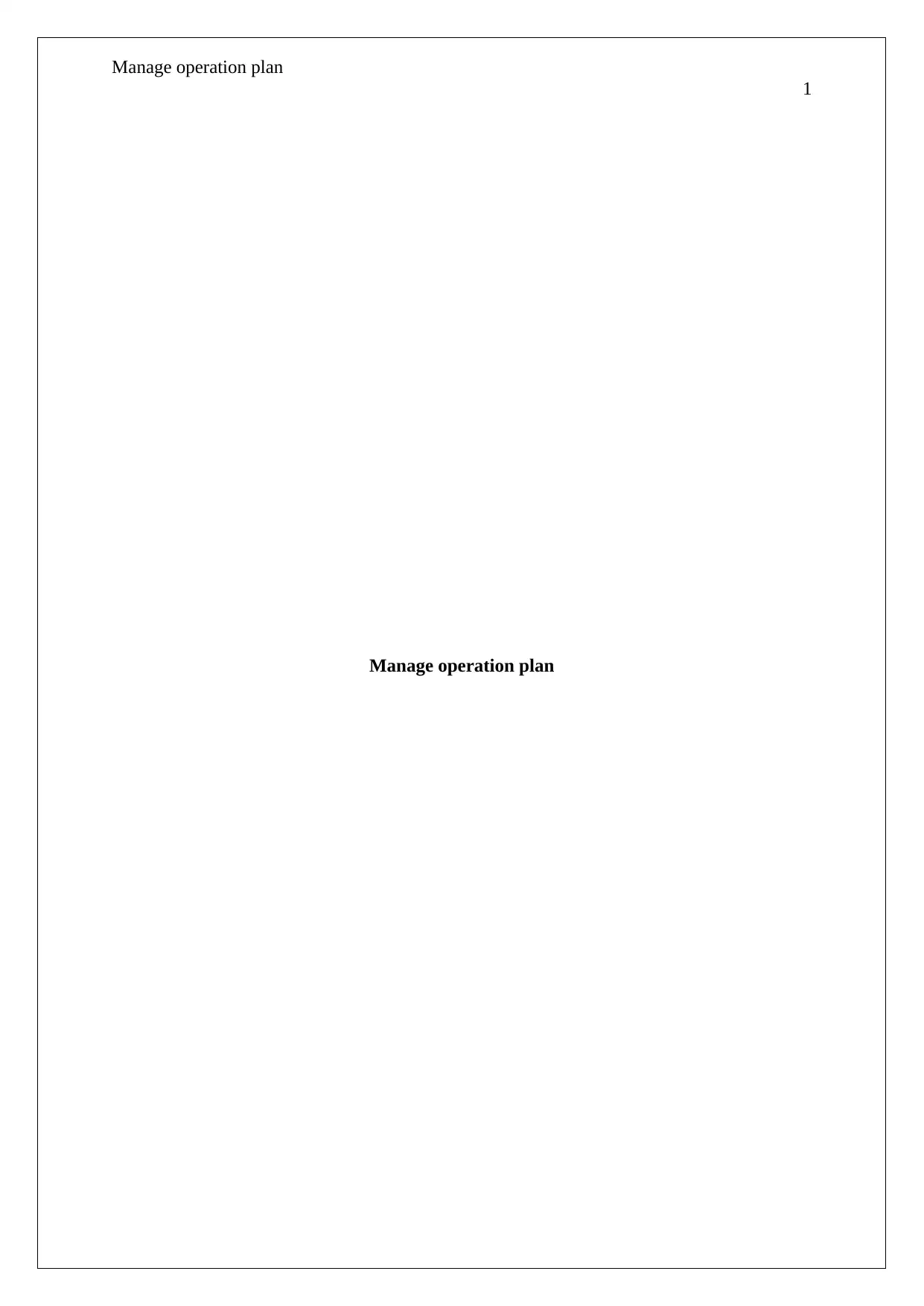
Manage operation plan
1
Manage operation plan
1
Manage operation plan
Paraphrase This Document
Need a fresh take? Get an instant paraphrase of this document with our AI Paraphraser
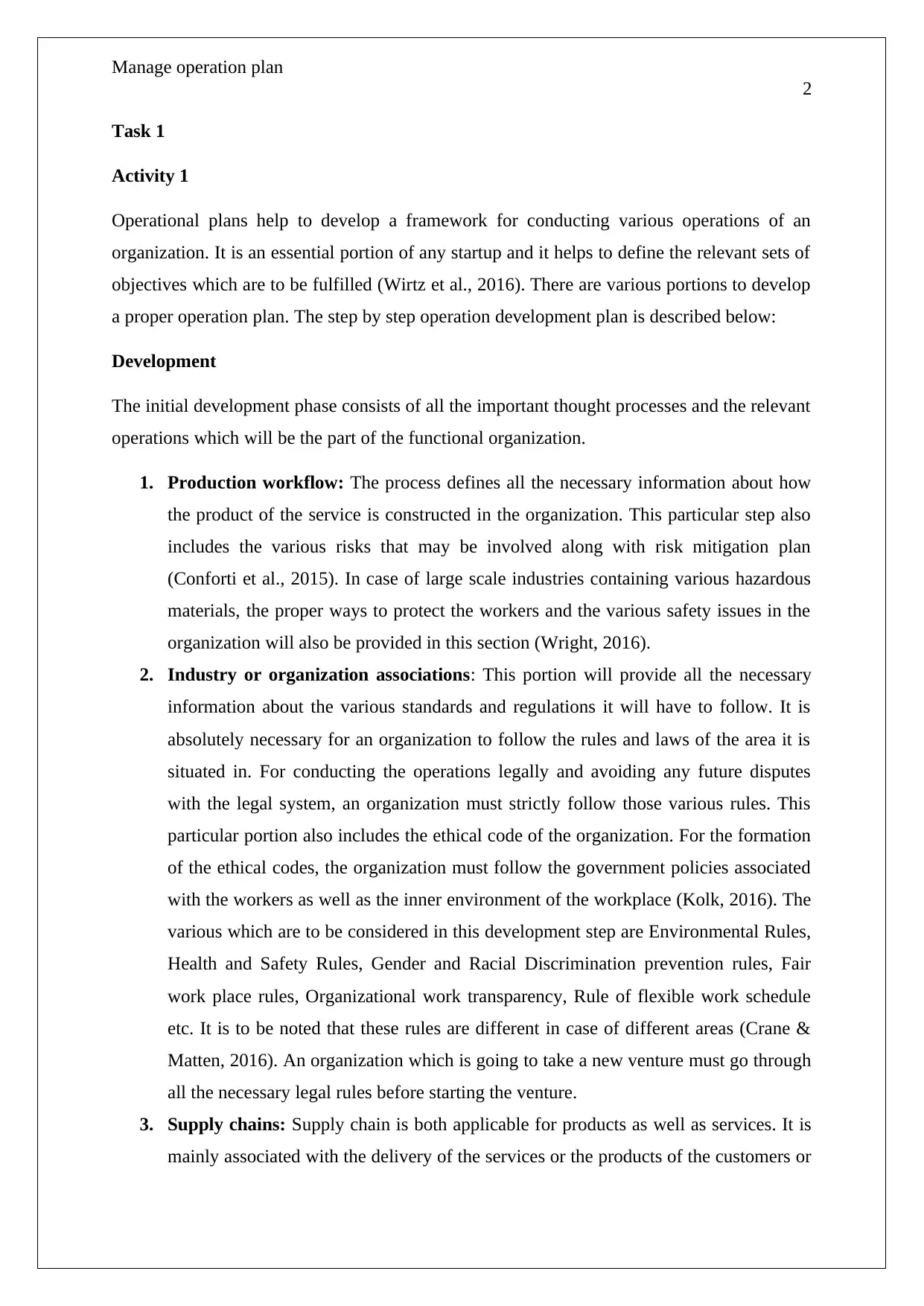
Manage operation plan
2
Task 1
Activity 1
Operational plans help to develop a framework for conducting various operations of an
organization. It is an essential portion of any startup and it helps to define the relevant sets of
objectives which are to be fulfilled (Wirtz et al., 2016). There are various portions to develop
a proper operation plan. The step by step operation development plan is described below:
Development
The initial development phase consists of all the important thought processes and the relevant
operations which will be the part of the functional organization.
1. Production workflow: The process defines all the necessary information about how
the product of the service is constructed in the organization. This particular step also
includes the various risks that may be involved along with risk mitigation plan
(Conforti et al., 2015). In case of large scale industries containing various hazardous
materials, the proper ways to protect the workers and the various safety issues in the
organization will also be provided in this section (Wright, 2016).
2. Industry or organization associations: This portion will provide all the necessary
information about the various standards and regulations it will have to follow. It is
absolutely necessary for an organization to follow the rules and laws of the area it is
situated in. For conducting the operations legally and avoiding any future disputes
with the legal system, an organization must strictly follow those various rules. This
particular portion also includes the ethical code of the organization. For the formation
of the ethical codes, the organization must follow the government policies associated
with the workers as well as the inner environment of the workplace (Kolk, 2016). The
various which are to be considered in this development step are Environmental Rules,
Health and Safety Rules, Gender and Racial Discrimination prevention rules, Fair
work place rules, Organizational work transparency, Rule of flexible work schedule
etc. It is to be noted that these rules are different in case of different areas (Crane &
Matten, 2016). An organization which is going to take a new venture must go through
all the necessary legal rules before starting the venture.
3. Supply chains: Supply chain is both applicable for products as well as services. It is
mainly associated with the delivery of the services or the products of the customers or
2
Task 1
Activity 1
Operational plans help to develop a framework for conducting various operations of an
organization. It is an essential portion of any startup and it helps to define the relevant sets of
objectives which are to be fulfilled (Wirtz et al., 2016). There are various portions to develop
a proper operation plan. The step by step operation development plan is described below:
Development
The initial development phase consists of all the important thought processes and the relevant
operations which will be the part of the functional organization.
1. Production workflow: The process defines all the necessary information about how
the product of the service is constructed in the organization. This particular step also
includes the various risks that may be involved along with risk mitigation plan
(Conforti et al., 2015). In case of large scale industries containing various hazardous
materials, the proper ways to protect the workers and the various safety issues in the
organization will also be provided in this section (Wright, 2016).
2. Industry or organization associations: This portion will provide all the necessary
information about the various standards and regulations it will have to follow. It is
absolutely necessary for an organization to follow the rules and laws of the area it is
situated in. For conducting the operations legally and avoiding any future disputes
with the legal system, an organization must strictly follow those various rules. This
particular portion also includes the ethical code of the organization. For the formation
of the ethical codes, the organization must follow the government policies associated
with the workers as well as the inner environment of the workplace (Kolk, 2016). The
various which are to be considered in this development step are Environmental Rules,
Health and Safety Rules, Gender and Racial Discrimination prevention rules, Fair
work place rules, Organizational work transparency, Rule of flexible work schedule
etc. It is to be noted that these rules are different in case of different areas (Crane &
Matten, 2016). An organization which is going to take a new venture must go through
all the necessary legal rules before starting the venture.
3. Supply chains: Supply chain is both applicable for products as well as services. It is
mainly associated with the delivery of the services or the products of the customers or
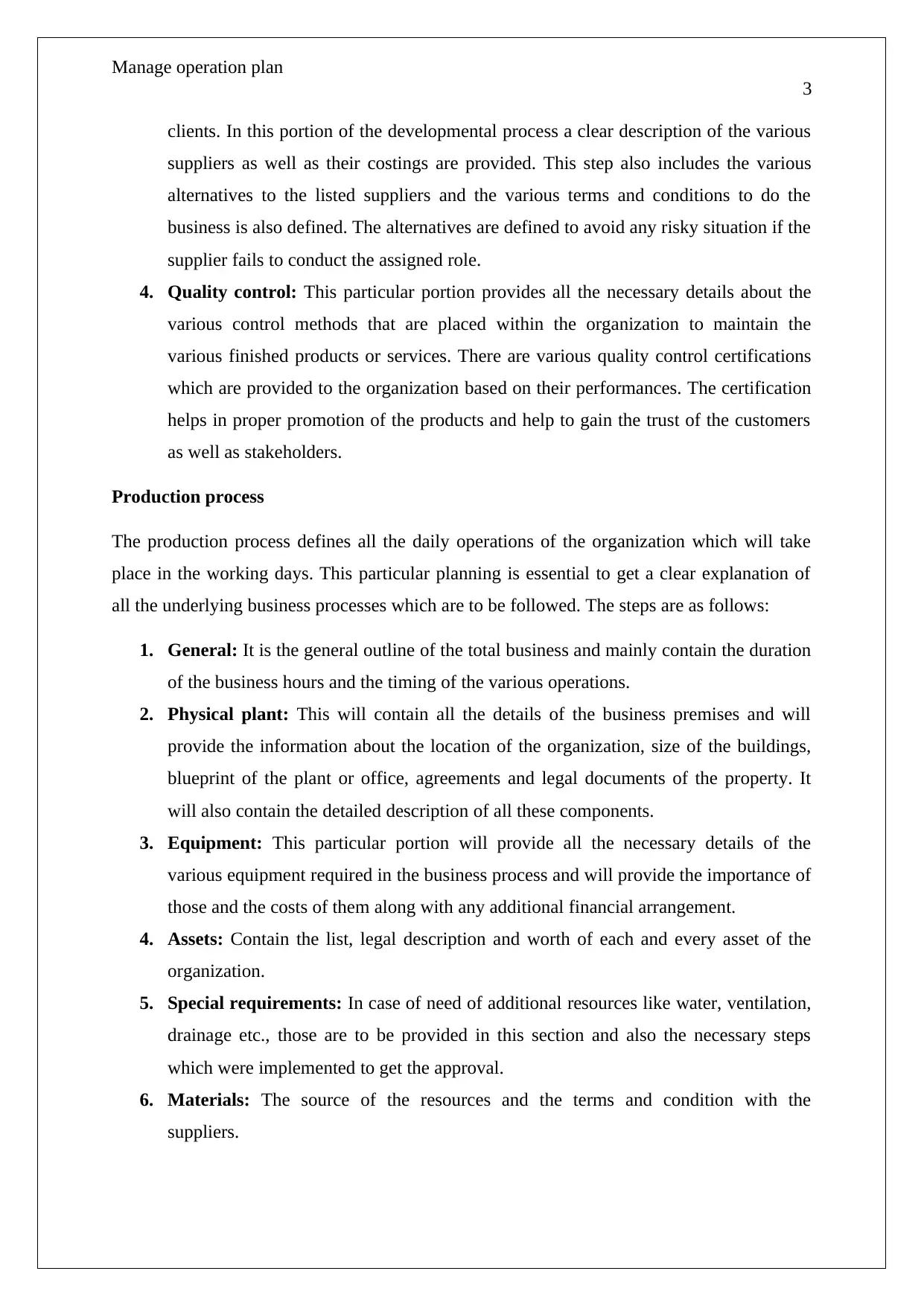
Manage operation plan
3
clients. In this portion of the developmental process a clear description of the various
suppliers as well as their costings are provided. This step also includes the various
alternatives to the listed suppliers and the various terms and conditions to do the
business is also defined. The alternatives are defined to avoid any risky situation if the
supplier fails to conduct the assigned role.
4. Quality control: This particular portion provides all the necessary details about the
various control methods that are placed within the organization to maintain the
various finished products or services. There are various quality control certifications
which are provided to the organization based on their performances. The certification
helps in proper promotion of the products and help to gain the trust of the customers
as well as stakeholders.
Production process
The production process defines all the daily operations of the organization which will take
place in the working days. This particular planning is essential to get a clear explanation of
all the underlying business processes which are to be followed. The steps are as follows:
1. General: It is the general outline of the total business and mainly contain the duration
of the business hours and the timing of the various operations.
2. Physical plant: This will contain all the details of the business premises and will
provide the information about the location of the organization, size of the buildings,
blueprint of the plant or office, agreements and legal documents of the property. It
will also contain the detailed description of all these components.
3. Equipment: This particular portion will provide all the necessary details of the
various equipment required in the business process and will provide the importance of
those and the costs of them along with any additional financial arrangement.
4. Assets: Contain the list, legal description and worth of each and every asset of the
organization.
5. Special requirements: In case of need of additional resources like water, ventilation,
drainage etc., those are to be provided in this section and also the necessary steps
which were implemented to get the approval.
6. Materials: The source of the resources and the terms and condition with the
suppliers.
3
clients. In this portion of the developmental process a clear description of the various
suppliers as well as their costings are provided. This step also includes the various
alternatives to the listed suppliers and the various terms and conditions to do the
business is also defined. The alternatives are defined to avoid any risky situation if the
supplier fails to conduct the assigned role.
4. Quality control: This particular portion provides all the necessary details about the
various control methods that are placed within the organization to maintain the
various finished products or services. There are various quality control certifications
which are provided to the organization based on their performances. The certification
helps in proper promotion of the products and help to gain the trust of the customers
as well as stakeholders.
Production process
The production process defines all the daily operations of the organization which will take
place in the working days. This particular planning is essential to get a clear explanation of
all the underlying business processes which are to be followed. The steps are as follows:
1. General: It is the general outline of the total business and mainly contain the duration
of the business hours and the timing of the various operations.
2. Physical plant: This will contain all the details of the business premises and will
provide the information about the location of the organization, size of the buildings,
blueprint of the plant or office, agreements and legal documents of the property. It
will also contain the detailed description of all these components.
3. Equipment: This particular portion will provide all the necessary details of the
various equipment required in the business process and will provide the importance of
those and the costs of them along with any additional financial arrangement.
4. Assets: Contain the list, legal description and worth of each and every asset of the
organization.
5. Special requirements: In case of need of additional resources like water, ventilation,
drainage etc., those are to be provided in this section and also the necessary steps
which were implemented to get the approval.
6. Materials: The source of the resources and the terms and condition with the
suppliers.
⊘ This is a preview!⊘
Do you want full access?
Subscribe today to unlock all pages.

Trusted by 1+ million students worldwide
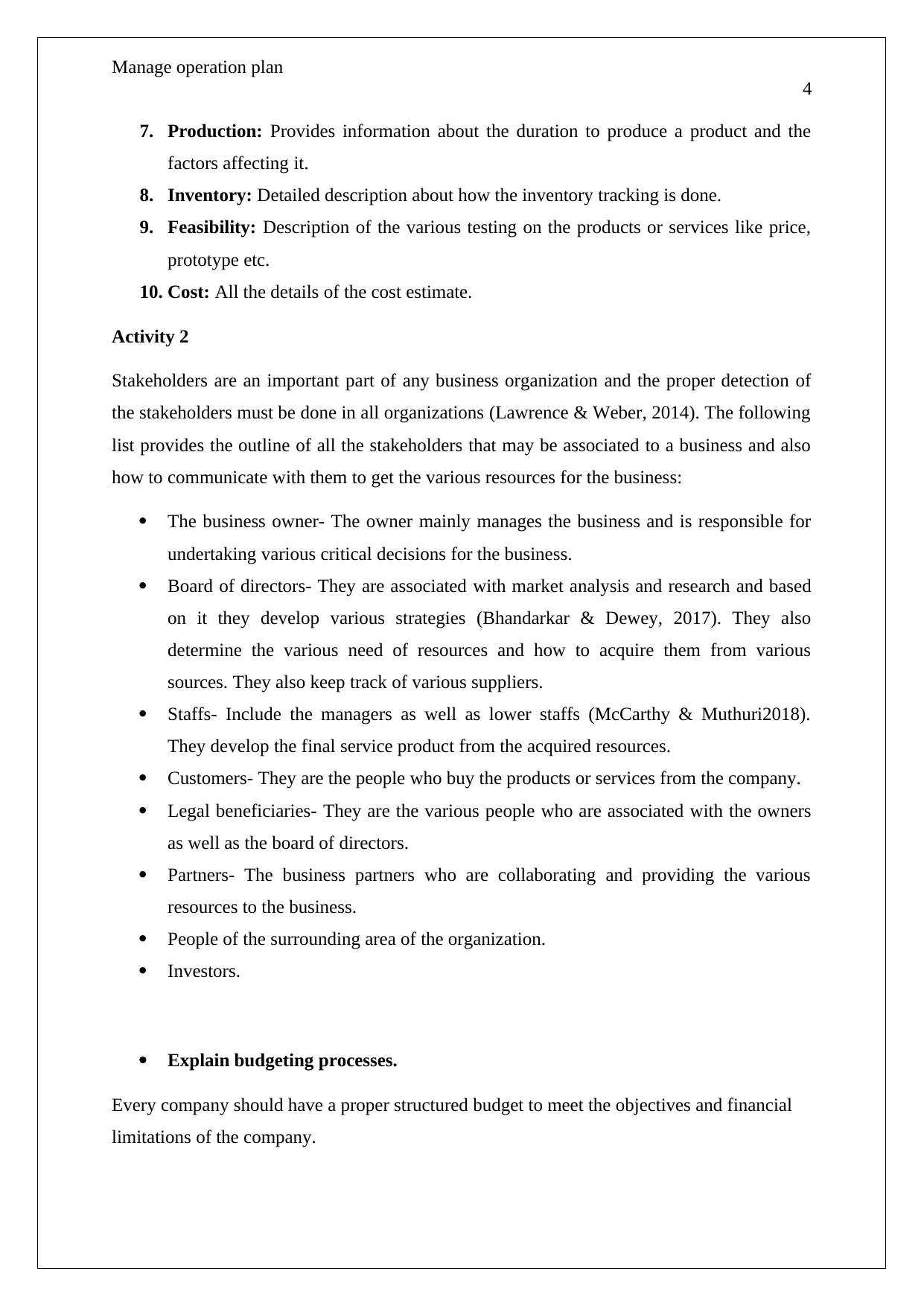
Manage operation plan
4
7. Production: Provides information about the duration to produce a product and the
factors affecting it.
8. Inventory: Detailed description about how the inventory tracking is done.
9. Feasibility: Description of the various testing on the products or services like price,
prototype etc.
10. Cost: All the details of the cost estimate.
Activity 2
Stakeholders are an important part of any business organization and the proper detection of
the stakeholders must be done in all organizations (Lawrence & Weber, 2014). The following
list provides the outline of all the stakeholders that may be associated to a business and also
how to communicate with them to get the various resources for the business:
The business owner- The owner mainly manages the business and is responsible for
undertaking various critical decisions for the business.
Board of directors- They are associated with market analysis and research and based
on it they develop various strategies (Bhandarkar & Dewey, 2017). They also
determine the various need of resources and how to acquire them from various
sources. They also keep track of various suppliers.
Staffs- Include the managers as well as lower staffs (McCarthy & Muthuri2018).
They develop the final service product from the acquired resources.
Customers- They are the people who buy the products or services from the company.
Legal beneficiaries- They are the various people who are associated with the owners
as well as the board of directors.
Partners- The business partners who are collaborating and providing the various
resources to the business.
People of the surrounding area of the organization.
Investors.
Explain budgeting processes.
Every company should have a proper structured budget to meet the objectives and financial
limitations of the company.
4
7. Production: Provides information about the duration to produce a product and the
factors affecting it.
8. Inventory: Detailed description about how the inventory tracking is done.
9. Feasibility: Description of the various testing on the products or services like price,
prototype etc.
10. Cost: All the details of the cost estimate.
Activity 2
Stakeholders are an important part of any business organization and the proper detection of
the stakeholders must be done in all organizations (Lawrence & Weber, 2014). The following
list provides the outline of all the stakeholders that may be associated to a business and also
how to communicate with them to get the various resources for the business:
The business owner- The owner mainly manages the business and is responsible for
undertaking various critical decisions for the business.
Board of directors- They are associated with market analysis and research and based
on it they develop various strategies (Bhandarkar & Dewey, 2017). They also
determine the various need of resources and how to acquire them from various
sources. They also keep track of various suppliers.
Staffs- Include the managers as well as lower staffs (McCarthy & Muthuri2018).
They develop the final service product from the acquired resources.
Customers- They are the people who buy the products or services from the company.
Legal beneficiaries- They are the various people who are associated with the owners
as well as the board of directors.
Partners- The business partners who are collaborating and providing the various
resources to the business.
People of the surrounding area of the organization.
Investors.
Explain budgeting processes.
Every company should have a proper structured budget to meet the objectives and financial
limitations of the company.
Paraphrase This Document
Need a fresh take? Get an instant paraphrase of this document with our AI Paraphraser
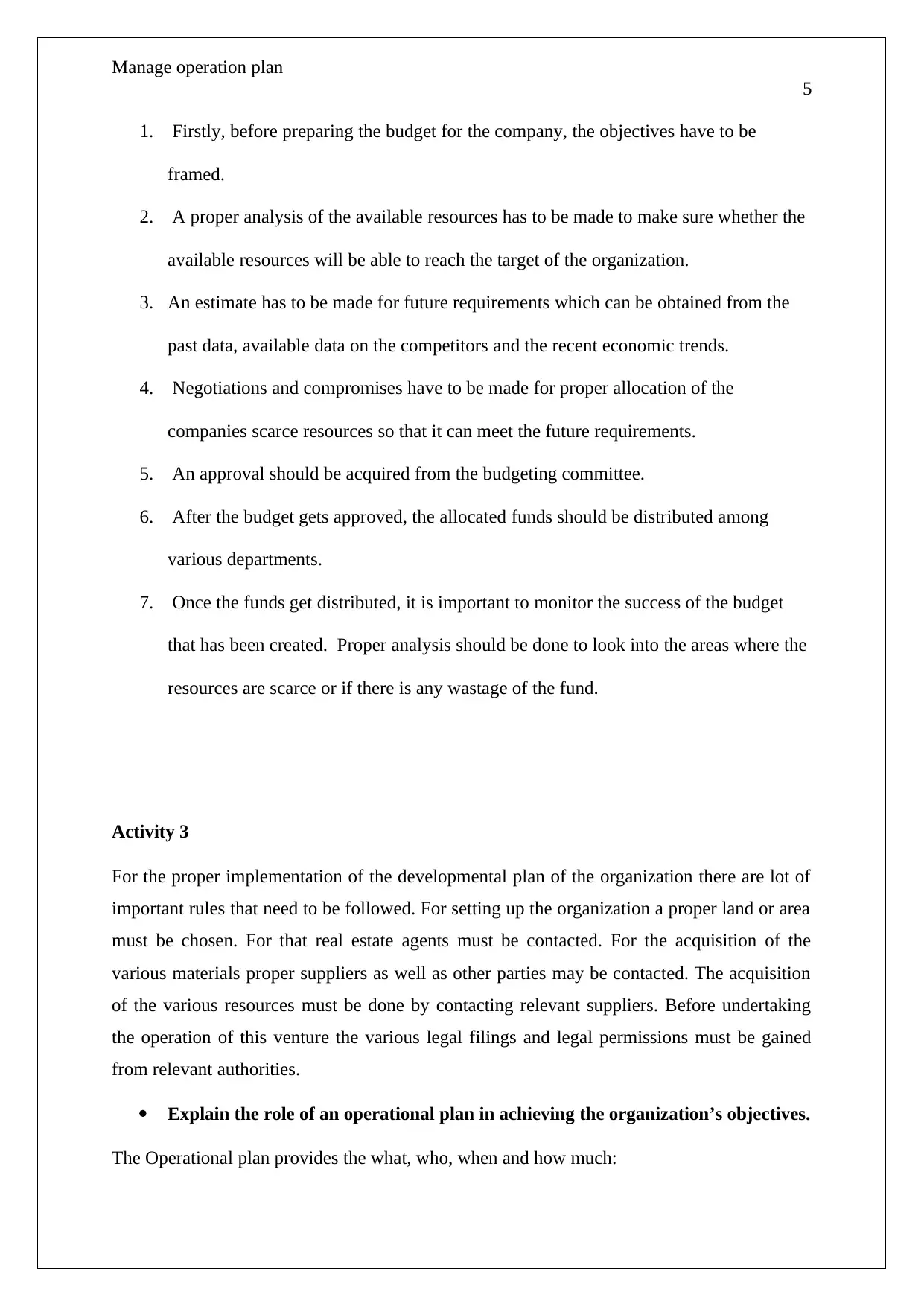
Manage operation plan
5
1. Firstly, before preparing the budget for the company, the objectives have to be
framed.
2. A proper analysis of the available resources has to be made to make sure whether the
available resources will be able to reach the target of the organization.
3. An estimate has to be made for future requirements which can be obtained from the
past data, available data on the competitors and the recent economic trends.
4. Negotiations and compromises have to be made for proper allocation of the
companies scarce resources so that it can meet the future requirements.
5. An approval should be acquired from the budgeting committee.
6. After the budget gets approved, the allocated funds should be distributed among
various departments.
7. Once the funds get distributed, it is important to monitor the success of the budget
that has been created. Proper analysis should be done to look into the areas where the
resources are scarce or if there is any wastage of the fund.
Activity 3
For the proper implementation of the developmental plan of the organization there are lot of
important rules that need to be followed. For setting up the organization a proper land or area
must be chosen. For that real estate agents must be contacted. For the acquisition of the
various materials proper suppliers as well as other parties may be contacted. The acquisition
of the various resources must be done by contacting relevant suppliers. Before undertaking
the operation of this venture the various legal filings and legal permissions must be gained
from relevant authorities.
Explain the role of an operational plan in achieving the organization’s objectives.
The Operational plan provides the what, who, when and how much:
5
1. Firstly, before preparing the budget for the company, the objectives have to be
framed.
2. A proper analysis of the available resources has to be made to make sure whether the
available resources will be able to reach the target of the organization.
3. An estimate has to be made for future requirements which can be obtained from the
past data, available data on the competitors and the recent economic trends.
4. Negotiations and compromises have to be made for proper allocation of the
companies scarce resources so that it can meet the future requirements.
5. An approval should be acquired from the budgeting committee.
6. After the budget gets approved, the allocated funds should be distributed among
various departments.
7. Once the funds get distributed, it is important to monitor the success of the budget
that has been created. Proper analysis should be done to look into the areas where the
resources are scarce or if there is any wastage of the fund.
Activity 3
For the proper implementation of the developmental plan of the organization there are lot of
important rules that need to be followed. For setting up the organization a proper land or area
must be chosen. For that real estate agents must be contacted. For the acquisition of the
various materials proper suppliers as well as other parties may be contacted. The acquisition
of the various resources must be done by contacting relevant suppliers. Before undertaking
the operation of this venture the various legal filings and legal permissions must be gained
from relevant authorities.
Explain the role of an operational plan in achieving the organization’s objectives.
The Operational plan provides the what, who, when and how much:
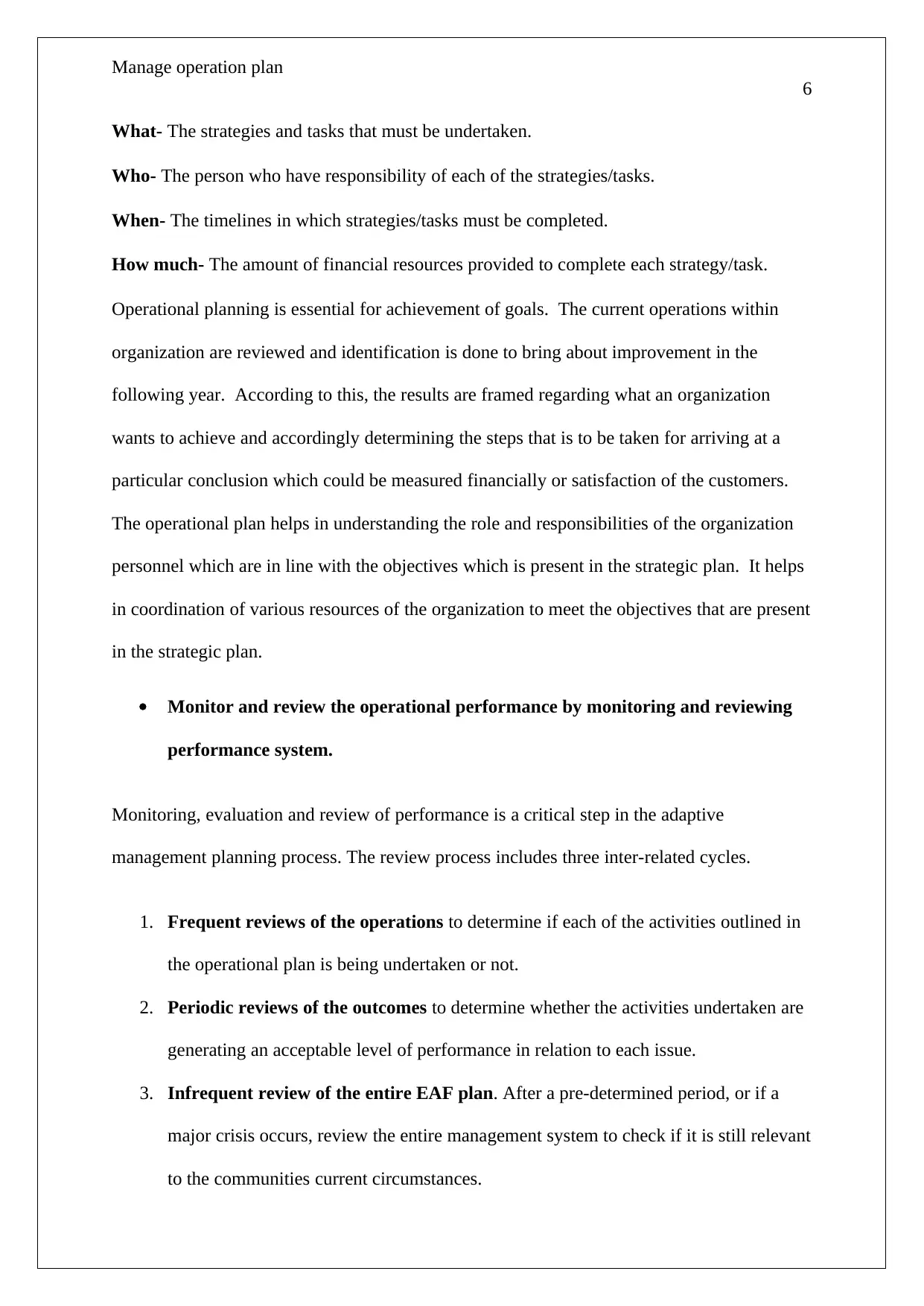
Manage operation plan
6
What- The strategies and tasks that must be undertaken.
Who- The person who have responsibility of each of the strategies/tasks.
When- The timelines in which strategies/tasks must be completed.
How much- The amount of financial resources provided to complete each strategy/task.
Operational planning is essential for achievement of goals. The current operations within
organization are reviewed and identification is done to bring about improvement in the
following year. According to this, the results are framed regarding what an organization
wants to achieve and accordingly determining the steps that is to be taken for arriving at a
particular conclusion which could be measured financially or satisfaction of the customers.
The operational plan helps in understanding the role and responsibilities of the organization
personnel which are in line with the objectives which is present in the strategic plan. It helps
in coordination of various resources of the organization to meet the objectives that are present
in the strategic plan.
Monitor and review the operational performance by monitoring and reviewing
performance system.
Monitoring, evaluation and review of performance is a critical step in the adaptive
management planning process. The review process includes three inter-related cycles.
1. Frequent reviews of the operations to determine if each of the activities outlined in
the operational plan is being undertaken or not.
2. Periodic reviews of the outcomes to determine whether the activities undertaken are
generating an acceptable level of performance in relation to each issue.
3. Infrequent review of the entire EAF plan. After a pre-determined period, or if a
major crisis occurs, review the entire management system to check if it is still relevant
to the communities current circumstances.
6
What- The strategies and tasks that must be undertaken.
Who- The person who have responsibility of each of the strategies/tasks.
When- The timelines in which strategies/tasks must be completed.
How much- The amount of financial resources provided to complete each strategy/task.
Operational planning is essential for achievement of goals. The current operations within
organization are reviewed and identification is done to bring about improvement in the
following year. According to this, the results are framed regarding what an organization
wants to achieve and accordingly determining the steps that is to be taken for arriving at a
particular conclusion which could be measured financially or satisfaction of the customers.
The operational plan helps in understanding the role and responsibilities of the organization
personnel which are in line with the objectives which is present in the strategic plan. It helps
in coordination of various resources of the organization to meet the objectives that are present
in the strategic plan.
Monitor and review the operational performance by monitoring and reviewing
performance system.
Monitoring, evaluation and review of performance is a critical step in the adaptive
management planning process. The review process includes three inter-related cycles.
1. Frequent reviews of the operations to determine if each of the activities outlined in
the operational plan is being undertaken or not.
2. Periodic reviews of the outcomes to determine whether the activities undertaken are
generating an acceptable level of performance in relation to each issue.
3. Infrequent review of the entire EAF plan. After a pre-determined period, or if a
major crisis occurs, review the entire management system to check if it is still relevant
to the communities current circumstances.
⊘ This is a preview!⊘
Do you want full access?
Subscribe today to unlock all pages.

Trusted by 1+ million students worldwide
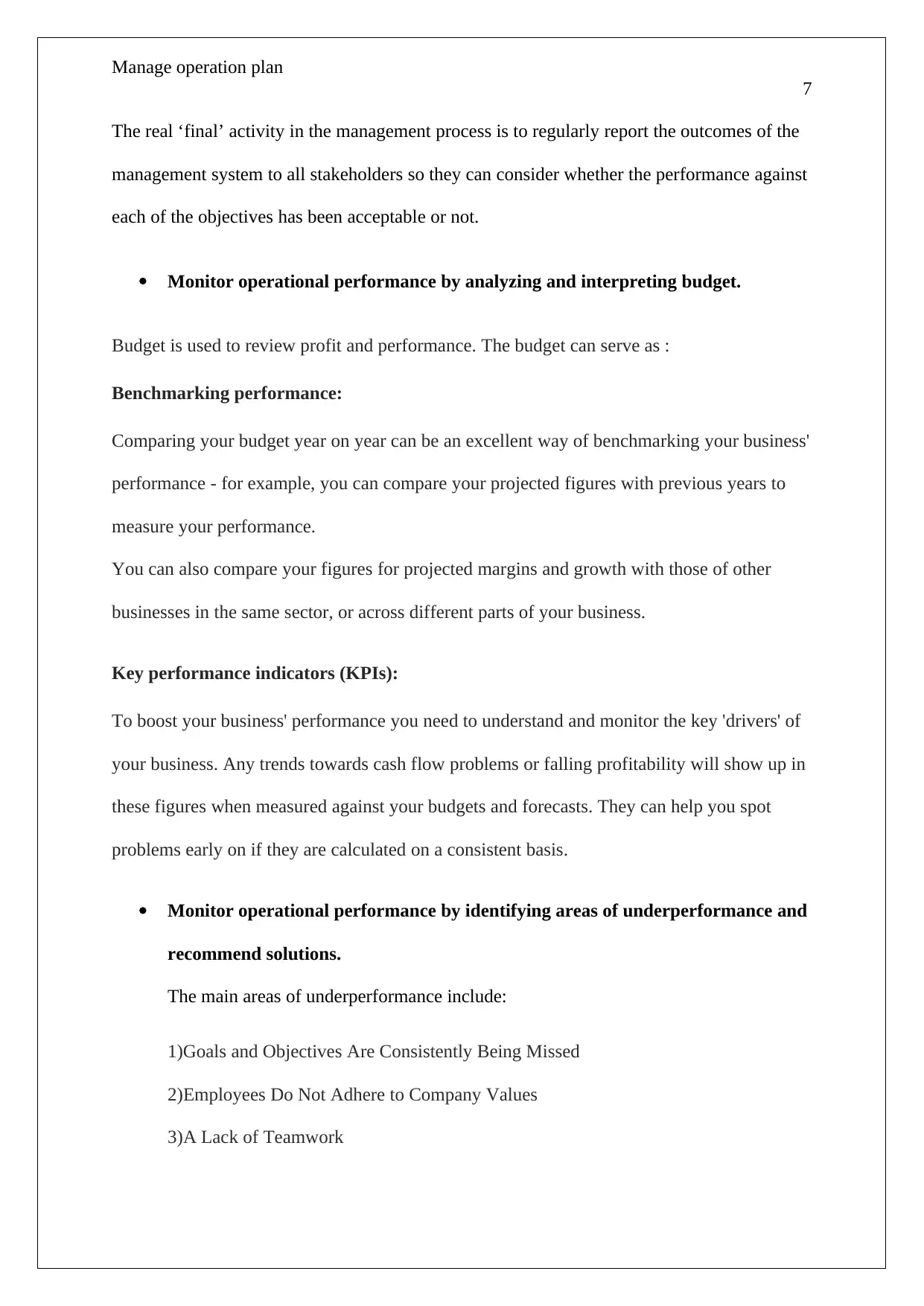
Manage operation plan
7
The real ‘final’ activity in the management process is to regularly report the outcomes of the
management system to all stakeholders so they can consider whether the performance against
each of the objectives has been acceptable or not.
Monitor operational performance by analyzing and interpreting budget.
Budget is used to review profit and performance. The budget can serve as :
Benchmarking performance:
Comparing your budget year on year can be an excellent way of benchmarking your business'
performance - for example, you can compare your projected figures with previous years to
measure your performance.
You can also compare your figures for projected margins and growth with those of other
businesses in the same sector, or across different parts of your business.
Key performance indicators (KPIs):
To boost your business' performance you need to understand and monitor the key 'drivers' of
your business. Any trends towards cash flow problems or falling profitability will show up in
these figures when measured against your budgets and forecasts. They can help you spot
problems early on if they are calculated on a consistent basis.
Monitor operational performance by identifying areas of underperformance and
recommend solutions.
The main areas of underperformance include:
1)Goals and Objectives Are Consistently Being Missed
2)Employees Do Not Adhere to Company Values
3)A Lack of Teamwork
7
The real ‘final’ activity in the management process is to regularly report the outcomes of the
management system to all stakeholders so they can consider whether the performance against
each of the objectives has been acceptable or not.
Monitor operational performance by analyzing and interpreting budget.
Budget is used to review profit and performance. The budget can serve as :
Benchmarking performance:
Comparing your budget year on year can be an excellent way of benchmarking your business'
performance - for example, you can compare your projected figures with previous years to
measure your performance.
You can also compare your figures for projected margins and growth with those of other
businesses in the same sector, or across different parts of your business.
Key performance indicators (KPIs):
To boost your business' performance you need to understand and monitor the key 'drivers' of
your business. Any trends towards cash flow problems or falling profitability will show up in
these figures when measured against your budgets and forecasts. They can help you spot
problems early on if they are calculated on a consistent basis.
Monitor operational performance by identifying areas of underperformance and
recommend solutions.
The main areas of underperformance include:
1)Goals and Objectives Are Consistently Being Missed
2)Employees Do Not Adhere to Company Values
3)A Lack of Teamwork
Paraphrase This Document
Need a fresh take? Get an instant paraphrase of this document with our AI Paraphraser
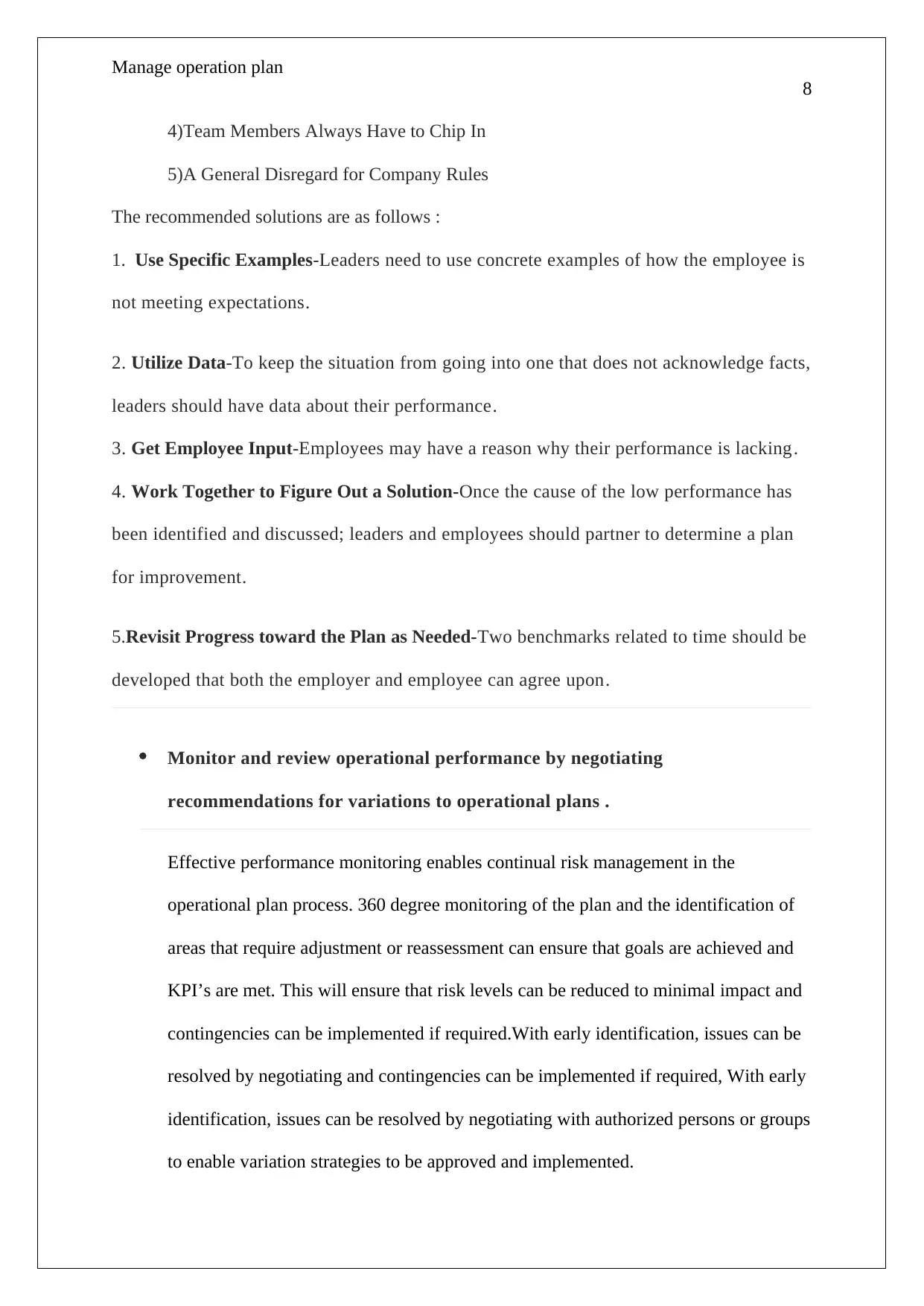
Manage operation plan
8
4)Team Members Always Have to Chip In
5)A General Disregard for Company Rules
The recommended solutions are as follows :
1. Use Specific Examples-Leaders need to use concrete examples of how the employee is
not meeting expectations.
2. Utilize Data-To keep the situation from going into one that does not acknowledge facts,
leaders should have data about their performance.
3. Get Employee Input-Employees may have a reason why their performance is lacking.
4. Work Together to Figure Out a Solution-Once the cause of the low performance has
been identified and discussed; leaders and employees should partner to determine a plan
for improvement.
5.Revisit Progress toward the Plan as Needed-Two benchmarks related to time should be
developed that both the employer and employee can agree upon.
Monitor and review operational performance by negotiating
recommendations for variations to operational plans .
Effective performance monitoring enables continual risk management in the
operational plan process. 360 degree monitoring of the plan and the identification of
areas that require adjustment or reassessment can ensure that goals are achieved and
KPI’s are met. This will ensure that risk levels can be reduced to minimal impact and
contingencies can be implemented if required.With early identification, issues can be
resolved by negotiating and contingencies can be implemented if required, With early
identification, issues can be resolved by negotiating with authorized persons or groups
to enable variation strategies to be approved and implemented.
8
4)Team Members Always Have to Chip In
5)A General Disregard for Company Rules
The recommended solutions are as follows :
1. Use Specific Examples-Leaders need to use concrete examples of how the employee is
not meeting expectations.
2. Utilize Data-To keep the situation from going into one that does not acknowledge facts,
leaders should have data about their performance.
3. Get Employee Input-Employees may have a reason why their performance is lacking.
4. Work Together to Figure Out a Solution-Once the cause of the low performance has
been identified and discussed; leaders and employees should partner to determine a plan
for improvement.
5.Revisit Progress toward the Plan as Needed-Two benchmarks related to time should be
developed that both the employer and employee can agree upon.
Monitor and review operational performance by negotiating
recommendations for variations to operational plans .
Effective performance monitoring enables continual risk management in the
operational plan process. 360 degree monitoring of the plan and the identification of
areas that require adjustment or reassessment can ensure that goals are achieved and
KPI’s are met. This will ensure that risk levels can be reduced to minimal impact and
contingencies can be implemented if required.With early identification, issues can be
resolved by negotiating and contingencies can be implemented if required, With early
identification, issues can be resolved by negotiating with authorized persons or groups
to enable variation strategies to be approved and implemented.
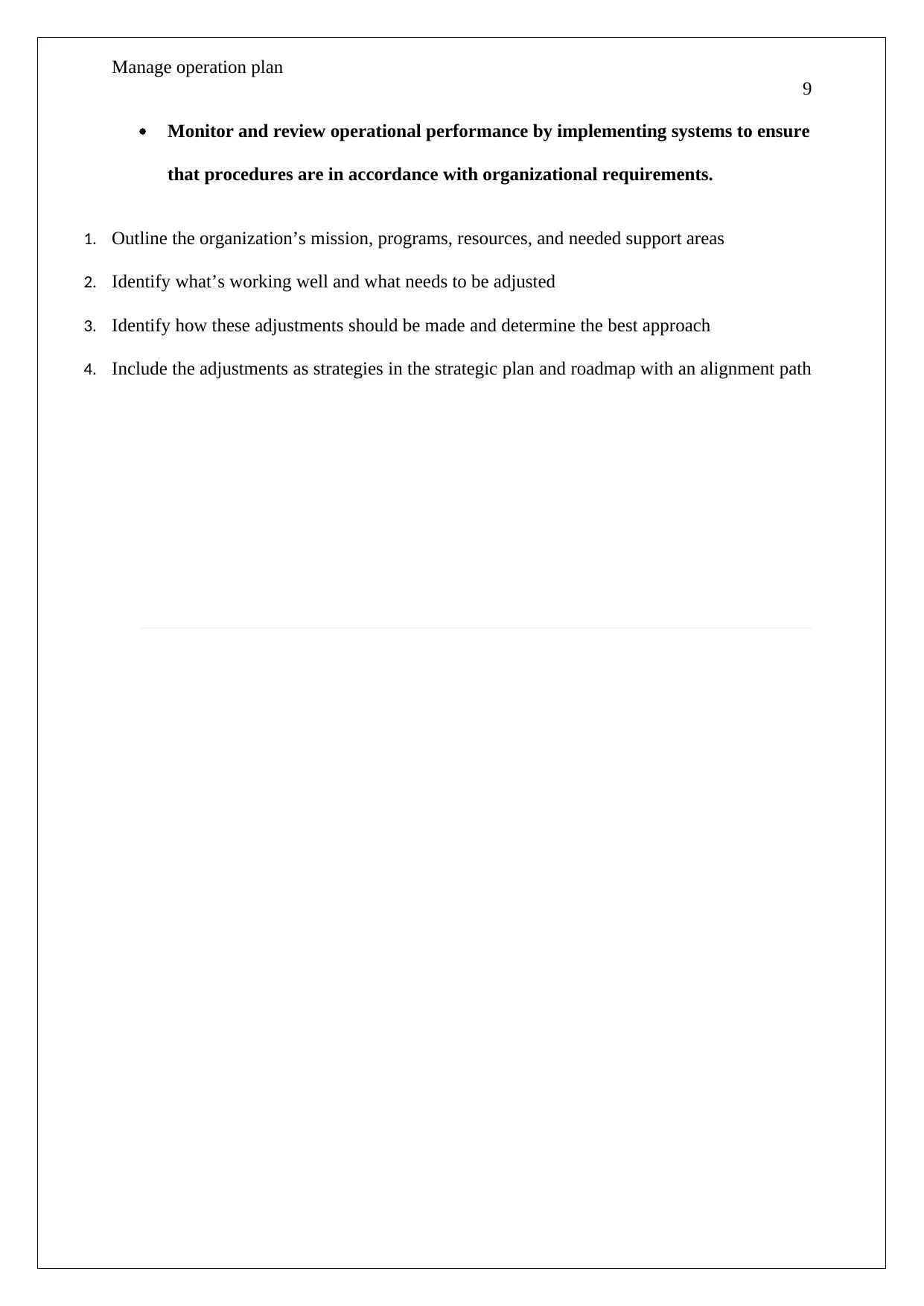
Manage operation plan
9
Monitor and review operational performance by implementing systems to ensure
that procedures are in accordance with organizational requirements.
1. Outline the organization’s mission, programs, resources, and needed support areas
2. Identify what’s working well and what needs to be adjusted
3. Identify how these adjustments should be made and determine the best approach
4. Include the adjustments as strategies in the strategic plan and roadmap with an alignment path
9
Monitor and review operational performance by implementing systems to ensure
that procedures are in accordance with organizational requirements.
1. Outline the organization’s mission, programs, resources, and needed support areas
2. Identify what’s working well and what needs to be adjusted
3. Identify how these adjustments should be made and determine the best approach
4. Include the adjustments as strategies in the strategic plan and roadmap with an alignment path
⊘ This is a preview!⊘
Do you want full access?
Subscribe today to unlock all pages.

Trusted by 1+ million students worldwide
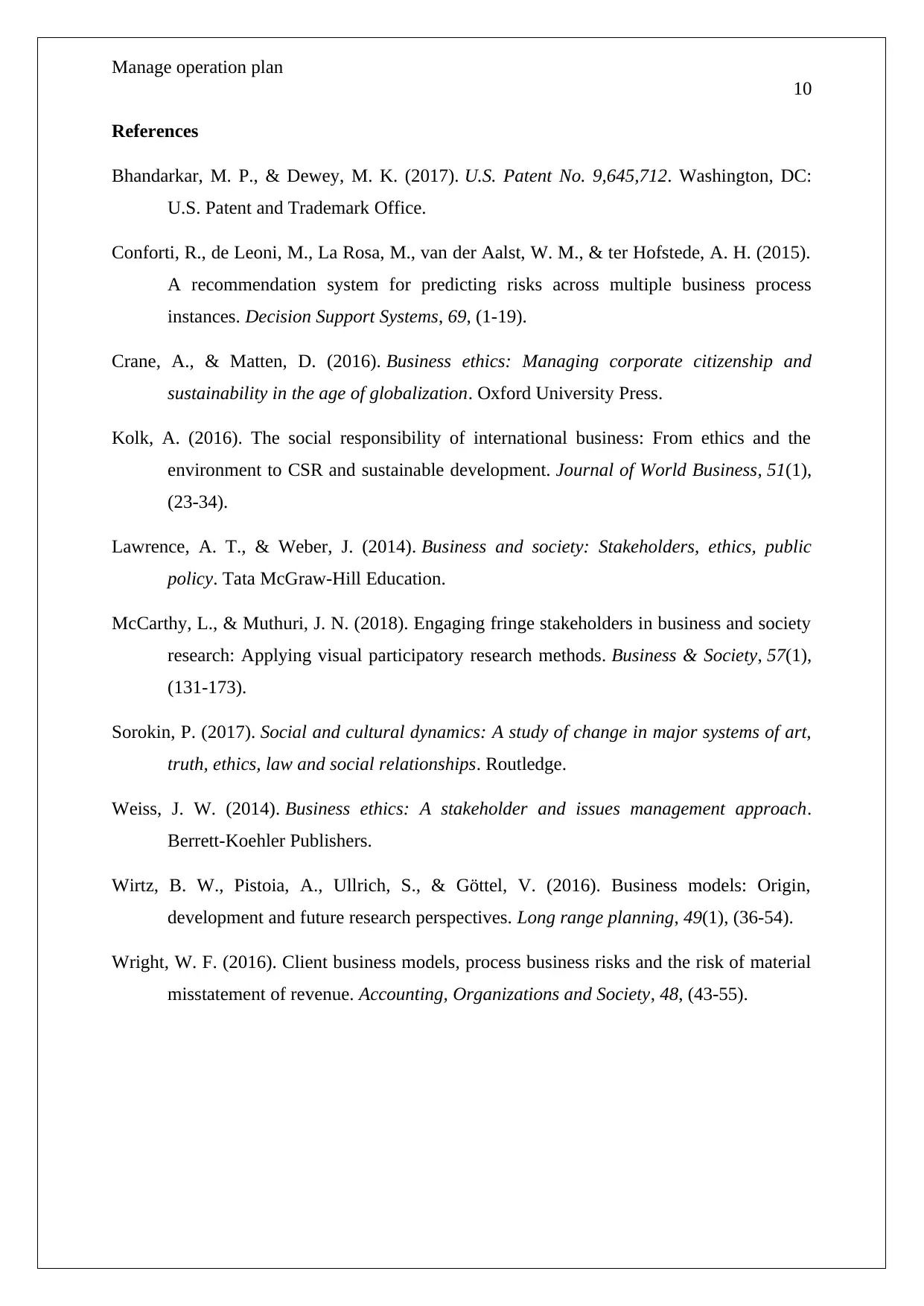
Manage operation plan
10
References
Bhandarkar, M. P., & Dewey, M. K. (2017). U.S. Patent No. 9,645,712. Washington, DC:
U.S. Patent and Trademark Office.
Conforti, R., de Leoni, M., La Rosa, M., van der Aalst, W. M., & ter Hofstede, A. H. (2015).
A recommendation system for predicting risks across multiple business process
instances. Decision Support Systems, 69, (1-19).
Crane, A., & Matten, D. (2016). Business ethics: Managing corporate citizenship and
sustainability in the age of globalization. Oxford University Press.
Kolk, A. (2016). The social responsibility of international business: From ethics and the
environment to CSR and sustainable development. Journal of World Business, 51(1),
(23-34).
Lawrence, A. T., & Weber, J. (2014). Business and society: Stakeholders, ethics, public
policy. Tata McGraw-Hill Education.
McCarthy, L., & Muthuri, J. N. (2018). Engaging fringe stakeholders in business and society
research: Applying visual participatory research methods. Business & Society, 57(1),
(131-173).
Sorokin, P. (2017). Social and cultural dynamics: A study of change in major systems of art,
truth, ethics, law and social relationships. Routledge.
Weiss, J. W. (2014). Business ethics: A stakeholder and issues management approach.
Berrett-Koehler Publishers.
Wirtz, B. W., Pistoia, A., Ullrich, S., & Göttel, V. (2016). Business models: Origin,
development and future research perspectives. Long range planning, 49(1), (36-54).
Wright, W. F. (2016). Client business models, process business risks and the risk of material
misstatement of revenue. Accounting, Organizations and Society, 48, (43-55).
10
References
Bhandarkar, M. P., & Dewey, M. K. (2017). U.S. Patent No. 9,645,712. Washington, DC:
U.S. Patent and Trademark Office.
Conforti, R., de Leoni, M., La Rosa, M., van der Aalst, W. M., & ter Hofstede, A. H. (2015).
A recommendation system for predicting risks across multiple business process
instances. Decision Support Systems, 69, (1-19).
Crane, A., & Matten, D. (2016). Business ethics: Managing corporate citizenship and
sustainability in the age of globalization. Oxford University Press.
Kolk, A. (2016). The social responsibility of international business: From ethics and the
environment to CSR and sustainable development. Journal of World Business, 51(1),
(23-34).
Lawrence, A. T., & Weber, J. (2014). Business and society: Stakeholders, ethics, public
policy. Tata McGraw-Hill Education.
McCarthy, L., & Muthuri, J. N. (2018). Engaging fringe stakeholders in business and society
research: Applying visual participatory research methods. Business & Society, 57(1),
(131-173).
Sorokin, P. (2017). Social and cultural dynamics: A study of change in major systems of art,
truth, ethics, law and social relationships. Routledge.
Weiss, J. W. (2014). Business ethics: A stakeholder and issues management approach.
Berrett-Koehler Publishers.
Wirtz, B. W., Pistoia, A., Ullrich, S., & Göttel, V. (2016). Business models: Origin,
development and future research perspectives. Long range planning, 49(1), (36-54).
Wright, W. F. (2016). Client business models, process business risks and the risk of material
misstatement of revenue. Accounting, Organizations and Society, 48, (43-55).
1 out of 10
Related Documents
Your All-in-One AI-Powered Toolkit for Academic Success.
+13062052269
info@desklib.com
Available 24*7 on WhatsApp / Email
![[object Object]](/_next/static/media/star-bottom.7253800d.svg)
Unlock your academic potential
Copyright © 2020–2025 A2Z Services. All Rights Reserved. Developed and managed by ZUCOL.




